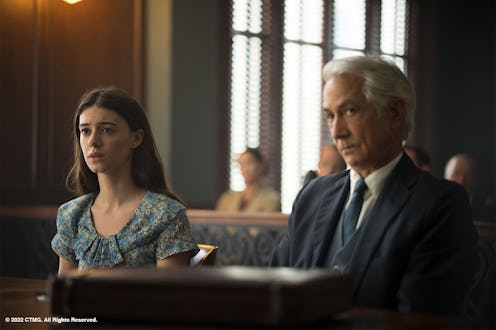Books
The Where The Crawdads Sing Movie Is Faithful To The Book
There is one key change in the movie’s ending, though.

Delia Owens, the author of bestselling book Where the Crawdads Sing, was pragmatic in her approach to novel-writing. Though she was interested in writing about an individual woman’s relationship with nature, she realized that she could reach more people if the story had thriller elements. “Wouldn’t it be great to write a book that had a strong storyline but also nature writing?” she thought. As she explained to BookPage, she ultimately concluded that “there needed to be a bomb under the sofa that [signals that] something more happens in this book,” which led to her novel’s dual-timeline structure. The new film adaptation, which stars Daisy Edgar-Jones and was produced by Reese Witherspoon, adopts that structure, jumping between protagonist Kya’s childhood and her trial for murder. But like any adaptation, it makes changes to the original material.
Screenwriter Lucy Alibar, who co-wrote the screenplay for Beasts of the Southern Wild, told Vanity Fair that she was recruited to adapt Owens’ book due to her Southern roots (she grew up in the Florida panhandle). “As soon as I started reading [Where the Crawdads Sing] I could see everything. That happens in my favorite novels,” she told the magazine. Soon, she and Owens were speaking frequently, with Owens providing advice and fact-checking about the natural world that Kya inhabits and studies as a budding naturalist. Alibar spent two years working on the script, melding romance and thriller elements just as Owens did.
The end of Owens’ novel contains a surprising twist — but did Alibar preserve it in the filmed version? Read on to discover the differences between the endings.
How does the book version of Where the Crawdads Sing end?
The central plot of Where the Crawdads Sing — the “strong storyline” Owens alludes to in her BookPage interview — is Kya’s murder trial. She’s accused of murdering Chase Andrews (Harris Dickinson), a former quarterback and local golden boy in their small town of Barkley Cove, after he’s found dead at the bottom of a fire tower in the marsh. Although the prosecution doesn’t have much evidence against Kya, she’s a social outcast in Barkley Cove because she grew up as a wild child in an isolated house deep within the marsh. It’s also common knowledge around town that she and Chase were in a relationship — despite him being engaged to someone else, a fact he conveniently chose not to share with Kya.
Fortunately, Kya has an alibi: She was out of town, in Greenville, for a publishing conference on the night of Chase’s death. Though the prosecution proves that it was technically possible for Kya to have traveled to and from Greenville to Barkley Cove in the middle of the night, the bus drivers called as witnesses don’t remember seeing her. Chase’s mother insists that Kya must have killed Chase because when his body was found, a necklace Kya gave him was missing, but as Kya’s lawyer, Tom Milton (David Strathairn), points out, the police didn’t find that necklace on Kya or on her property. He persuasively argues that the case against Kya is built not on fact but on prejudice, and the jury finds her not guilty.
Kya reunites with her old flame Tate (Taylor John Smith), and they build a life together living in her house in the marsh. Kya’s career as an author flourishes, and although she and Tate can’t have children, they leave a long and fulfilling life. Kya dies peacefully at the age of 64, and when Tate is sorting through her belongings, he unearths two long-hidden secrets. The first is that Kya had an alter ego in the form of Amanda Hamilton, a local poet whom Kya references and quotes throughout the novel. The second is that Kya was responsible for Chase’s death. Chase’s missing necklace is hidden in a box along with Kya’s poetry. One of the poems, “The Firefly,” describes the incident:
Luring him was as easy
As flashing valentines.
But like a lady firefly
They hid a secret call to die.
A final touch,
Unfinished;
The last step, a trap.
Down, down he falls,
His eyes still holding mine
Until they see another world.
I saw them change.
First a question,
Then an answer,
Finally an end.
And love itself passing
To whatever it was before it began. A.H.
What happens at the end of the movie version of Where the Crawdads Sing?
In most respects, the ending of the film adaptation of Where the Crawdads Sing stays true to the book — fans won’t be up in arms about big, dramatic changes. The court case is understandably streamlined in the movie to save time, but unfolds in much the same way. As in the novel, Kya finds happiness with Tate, and pursues a fulfilling career as a nature writer.
The primary difference between the movie and the book, at least in terms of the ending, is that the film doesn’t include Kya’s alternate life as a poet, or discuss her connection to poetry at all. Instead, the film depicts her creativity through her illustrations of the flora and fauna in the marsh around her. When Tate discovers that Kya did kill Chase, he doesn’t find a poem describing what happened — he just finds the necklace, and the rest of the details of what happened are left up to his, and the audience’s, imagination.